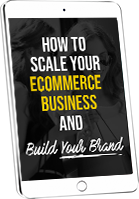Let me sum up as quickly as possible.
If you sell a physical product and are not selling on Amazon, you are losing money. Plain and simple.
Sure, there are implications and things to manage through, but if you want to make more money with your physical product business, then getting it up on Amazon is as close to a guaranteed way to do so as anything else. Particularly, if you are already selling direct-to-consumer.
The reason is not complicated but is multi-fold. For starters, there are a ton of people out there (myself included) who are Amazon buyers. What that means is that I’ve been known to see a product on another site, then I’ll check to see if it’s available on Amazon – if the pricing is even pretty close, I’ll buy it on Amazon rather than the other site (even if it’s a brand like Nordstrom which touts phenomenal customer service). My credit card is already in the system, I’m Prime so at worst I get 2-day shipping (and many times it’s same-day). How do you compete against that? You kinda don’t. You acknowledge and accept it and figure out how to benefit from it. Consumers are going there, and the forces are way bigger than any of us.
I’ve seen both first-hand and from countless marketers how Amazon is incremental to your business. Sure, maybe 2% of the business is cannibalized from your website, but I’ll give that up for the other 98%. And it is correct that you don’t own the customer – you get the customer info but you are not allowed to use that info to market to those customers. So, you can get more revenues and not own the customer? Ordinarily there is more nuance to it, but when it can add 10%-20% more revenues, those are not numbers to scoff at.
For direct-to-consumer marketers, the best way to get up and going is thru Amazon’s FBA (Fulfillment by Amazon) program, which essentially means you get your inventory to Amazon, which makes you eligible for Amazon Prime (again, do not underestimate how big a deal this is – many consumers only buy from Prime sellers). You can set up the listing, you control pricing, etc., and when someone orders, Amazon ships the product directly to the consumer. And for the most part, Amazon manages customer service issues, though you absolutely need to monitor reviews and feedback – it is your brand so that part you have to own.
For wholesale marketers who have their products sold in retail, it’s not as clean – and I’ve heard plenty of complaints – but again, it’s worth the effort. Amazon wants parity with other sellers, so if you’re available in Nordstrom or Dick’s Sporting Goods, for example, just as those folks get to set pricing, etc., Amazon wants to do the same. As such, you’ll likely, though not always, be managed through Amazon Retail – which means that Amazon will buy your inventory wholesale – and then they will manage most everything else from that point on.
How can you tell the difference as a consumer? See the 2 screenshots below:
In the first, “Fulfilled by Amazon” means it’s FBA. The “sold by” is the actual business selling the product. That is different than the brand of the product, which is just below the title. (Also notice that this product is available for same-day delivery if I order it before noon.)
In this second screenshot, the product “ships form and is sold by Amazon.” This is Amazon Retail. You’ll also notice that with Amazon Retail listings (other than a limited number of exceptions for FBA), the description field is a lot more elegantly designed with html, and there can be videos alongside the images at the top. There are benefits that Amazon Retail has over FBA.
Now, whether the items is FBA or Retail, that doesn’t mean there aren’t other sellers. Owning the Buy Box – essentially being the first seller to show up – takes work. Conversion rate, price, customer service, etc. are some of the factors that affect who shows up first. And if you’re a Retail partner who also sells as big name brick-and-mortar retail locations, it’s likely you’re going to see those same sellers on Amazon (or 3rd parties that took product off the hands of your wholesale partners). As such, I’ve known plenty of people who have complained about pricing issues (lower than preferred) on Amazon. There isn’t a perfect answer here, but if you have a reasonable amount of sales, you’ll likely get an Amazon rep who I would suggest building as strong a relationship with as possible – just know that people move around at Amazon every couple years, so this is a moving relationship…
Couple other items of note. Amazon’s internal boundaries as well as their technologies have set up a bit of a wall between FBA and Retail. It’s the same company and it looks like it’s happening in the same place, but this is just one of the legacy things happening there. Next, when it comes to reporting, Seller Central (for FBA) is significantly better than Vendor Central (for Retail). Again, just a legacy thing.
Bottom line, Amazon is only getting bigger and stronger. Better to embrace that fact and the relationship sooner.
Not to mention it’s very very likely going to make you more money.
Please leave a comment below because I’d like to hear what you think.
